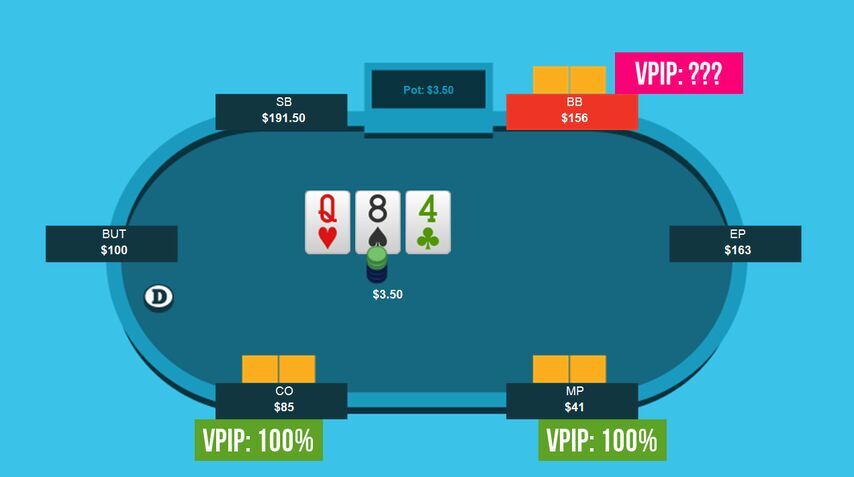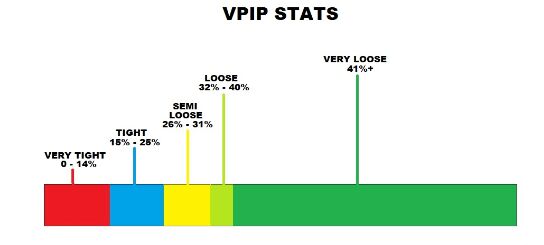VPIP is a common term in poker and is widely regarded as one of the most crucial stat in online poker. What is a VPIP in poker? The term VPIP stands for "voluntary put in pot" and refers to the frequency (or lack thereof) with which a player will put money into the pot before they see the flop. VPIP is essential because it provides insight into an opponent's playing technique and enables you to adjust your strategy accordingly.

Player Types and VPIP Stats
Understanding player types and their VPIP stats is crucial for success. VPIP provides insights into a player's willingness to engage in hands. It's often divided into ranges like tight (low VPIP) and loose (high VPIP). Recognising these ranges aids in adapting strategies and making better decisions at the table, giving players an edge in the ever-evolving game of poker.
- Tight-Passive (VPIP 15%): Poker players with a VPIP in this bracket tend to play a narrow range of premium hands. They are frequently prudent and selective, only entering pots with strong hands. It is crucial to proceed with caution when dealing with aggression from a tight-passive player, as they are likely to hold a strong hand.
- Tight-Aggressive (VPIP 15%-20%): Players in this range balance playing carefully and selectively while incorporating reasonable aggression. Combining strong starting hands with appropriate aggression, they are formidable opponents. Playing against a tight-aggressive opponent necessitates keen observation and a willingness to adapt to their style.
- Loose-Passive (VPIP 20%-30%): Players in this category have a looser approach to hand selection, yet their betting patterns lack aggressiveness. They frequently call rather than raise, expecting to hit a huge hand. Mounting pressure via well-timed bets and raises is how you exploit loose-passive opponents.
- Loose-Aggressive (VPIP > 30%): This type of player includes players with a high VPIP. They are eager to get into pots with various hands and typically use aggressive strategies such as betting and raising. Battling a loose-aggressive opponent may be difficult since their unpredictable nature necessitates adapting and solid decision-making skills.
- Aggro-Maniac (VPIP > 40%): These players are table maniacs and overly loose and will almost play any two cards. Recreational and amateur players fall into this category. They are the type of players you should always strive to play against since aggro maniacs will make you the most profit.

Although this is simply a basic guide, it should help you understand how to put a player on a range of hands based on their VPIP.
Essentially, the higher it is, the more hands you must add to their range. Meaning when you get to the loose players and recreational opponents, for example, 40% + VPIP, it seems senseless to bother creating a range of hands for them.
Harnessing your knowledge of VPIP in poker can greatly enhance your online gameplay on platforms like AmericasCardroom, 888 Poker, and PokerStars.






By understanding your opponents' tendencies to enter pots voluntarily, you can learn your opponents, adapt your strategy, and seize opportunities to maximise your winnings.
What is the Ideal VPIP
Generally, a good VPIP falls within a moderate range, typically between 15% and 25%. A player enters pots with good hands and avoids getting involved when they have weak or marginal starting hands. It is based on the assumption that you wish to play tight, are playing micro-stakes, and are playing at full-ring or 6-max cash tables.. You can also work on increasing your VPIP in lower buy-in events or freerolls if you want to experiment and improve your game.
- Increased first deposit bonus
- Increased rakeback and reloads
- Help with deposits and cashouts
- Access to private freerolls
- Round-the-clock support
If you are still learning to play poker well, you should be very selective with your hands, meaning a VPIP slightly below 15% is acceptable. The fewer players at the table, the more hands you can play. You may play loose if seated at a table with very tight players. A skilled player who knows the game's intricacies may get away with a VPIP of 20% to 27%. Most players have a substantially greater VPIP in 6-max or heads-up. VPIP values will be significantly higher in Pot-Limit Omaha.

The secret to determining an appropriate VPIP depends on establishing a balance. Adjusting your strategy based on the game's dynamics, the table composition and your opponents' tendencies is crucial. An ideal VPIP demonstrates a deliberate approach to hand selection, establishing an appropriate equilibrium between aggression and caution. Maintaining a good VPIP allows players to navigate the poker table with expertise, capitalising on advantageous situations while avoiding unnecessary risks.
Limitations and Considerations
When digging into player analysis, knowing the limits of relying exclusively on the VPIP statistic is essential. While VPIP gives vital insights about a player's tendency to enter pots voluntarily, players must consider other stats to acquire a complete knowledge of their overall performance. Using VPIP alone might lead to an inadequate evaluation of a player's strategy and style, sometimes missing important details.
In the course of assessing VPIP data, it is also important to consider sample size and statistical significance. Because random fluctuations might influence the findings, a small sample size can lead to inaccurate conclusions. Larger sample sizes should be considered to get more robust and accurate results.
In conclusion, although VPIP provides useful insights into a player's likelihood to join pots, it should be used only for thorough player analysis. Other aspects, such as playing style, position, and opponent dynamics, must be examined to build a more accurate perspective.
Furthermore, analyzing VPIP data needs focus since players must consider possible biases and contextual influences. Players can attain a more complete and insightful analysis by considering these elements.
















